A Comprehensive Guide to Concrete Patching: Materials, Processes, and Best Practices
This guide explains how to repair damaged concrete surfaces. It covers selecting the right patching materials for different types of damage, preparing the surface for a strong bond, and applying the patch correctly for a lasting repair. Following these steps helps ensure the patch integrates with the existing concrete and provides a durable, long-lasting finish.
Principles of Concrete Repair
What is Concrete Patching?
Concrete patching repairs localized damage like cracks, spalls, and pits. This maintenance extends the life of driveways, floors, and patios by preventing minor issues from becoming large structural problems. Water entering untreated cracks causes significant damage, especially in climates with freeze-thaw cycles. 1, 2
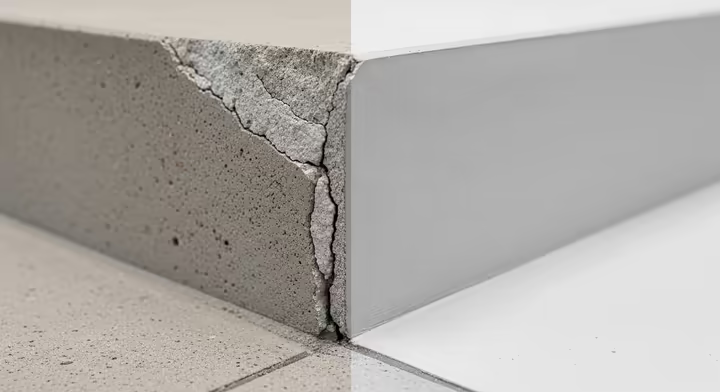
Patching both restores the concrete's structure and provides a sound foundation for surface finishes like paint. A failed patch will cause subsequent coatings to blister and peel. A stable, properly prepared patch is necessary for a quality finish. 5
Choosing Patching Materials
Choosing the right patching material depends on the type of damage, expected loads, and environmental conditions. Traditional mortars, made of Portland cement, sand, and water, have poor tensile strength and can shrink and crack. Polymer-modified mortars improve on this by adding acrylics, vinyls, or other latexes to the mix. 2, 8
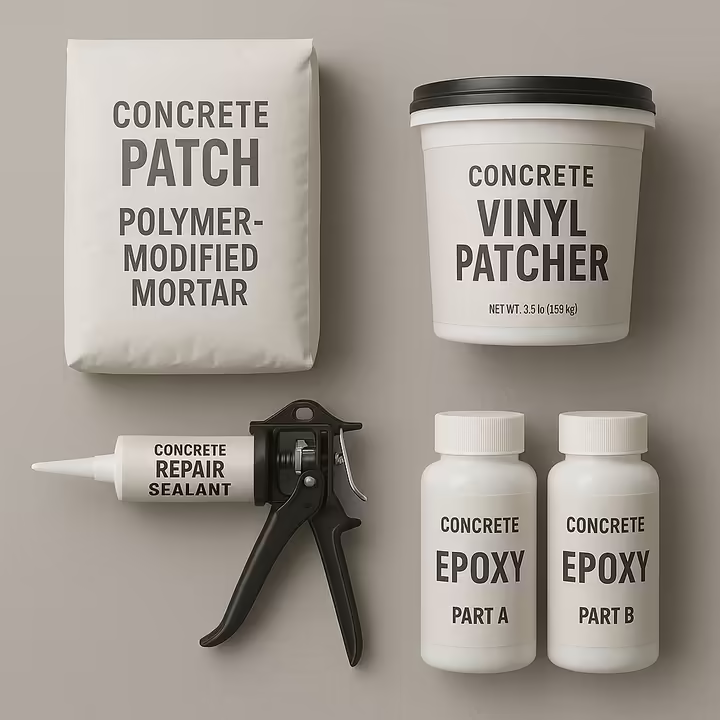
These polymers form an internal network that improves adhesion, increases flexural strength, and reduces water permeability. This also minimizes shrinkage, preventing the patch from pulling away from the substrate as it cures. Polymer modification is a reliable method for creating durable and versatile repair materials. 2, 8
Polymer-Modified and Rapid-Setting Cements
These versatile compounds are pre-blended mixes of Portland cement, graded sands, and polymer additives. Rapid-setting versions include agents like calcium sulfoaluminate cement to accelerate curing. They are suitable for repairing spalls, cracks, and holes on horizontal, vertical, and overhead surfaces. 8, 12, 13
Their high strength makes them ideal for load-bearing surfaces like driveways. They bond well to prepared concrete, often without a separate primer, and are formulated to resist shrinkage. For repairs deeper than two inches, many can be extended with pea gravel to make them more economical. 12, 13
Epoxy-Based Compounds
Epoxy repair compounds are two-component systems with an epoxy resin and a hardener. They are used in high-stress applications requiring exceptional bond strength, such as anchoring bolts or repairing cracks in industrial floors. The adhesive strength of epoxy can exceed the strength of the concrete itself. 5, 15
Epoxies offer superior resistance to chemicals and moisture with minimal shrinkage. However, their rate of thermal expansion differs from concrete, which can cause stress at the bond line in exterior applications with temperature swings. Manufacturers mitigate this by adding a high aggregate content to their epoxy mortars. 15
Hydraulic Cement
Hydraulic cement is formulated to set and harden extremely quickly, even when submerged in water. It is used primarily to plug active water leaks in basement walls, foundations, and swimming pools. The material expands slightly as it cures, wedging it into the crack to form a watertight seal. 19
Vinyl-Reinforced Compounds
These products are designed for thin repairs on horizontal surfaces like driveways, sidewalks, and patios. They consist of cement, fine sand, and a vinyl resin powder that acts as a bonding agent. Their main advantage is the ability to be applied from 1/4 inch down to a thin "feather edge" for a seamless transition. 9
Acrylic and Latex-Based Compounds
These flexible, ready-to-use compounds come in caulk tubes or tubs for easy application. They are designed for filling and sealing small, non-structural cracks up to 1/2 inch wide on both vertical and horizontal surfaces. After curing, they remain flexible, allowing them to accommodate minor movement in the concrete. 23, 27
Self-Leveling Underlayments
Self-leveling underlayments are flowable, cement-based compounds used to smooth out large, uneven interior concrete floors. They are not a final wear surface but prepare the floor for tile, carpet, or other flooring. When mixed, they form a fluid slurry that spreads out to create a flat, hard surface. 28
A specialized primer must be applied to the substrate beforehand to seal the concrete and ensure a strong bond. These products cure to high compressive strengths, typically in the range of 5,000 to 7,000 PSI. 28, 30
Feather-Edge Repair Products
Feather-edge compounds are polymer-modified materials engineered for the thinnest applications, such as skim coating or leveling surfaces before a coating is applied. Their strong bond and workability allow them to be troweled to a true zero edge without chipping. Many set quickly, allowing floor coverings to be installed soon after application. 22, 32
Patching Compound Properties
| Material Type | Typical Composition | Primary Use Case | Compressive Strength Range (PSI) | Key Adhesion/Bonding Feature | Typical Set Time | Max/Min Thickness | Suitability |
|---|---|---|---|---|---|---|---|
| Polymer-Modified Cement | Portland cement, sand, polymer additives | Structural repairs, spalls, deep cracks | 4,000 - 7,500+ | Polymer-enhanced bond, often no primer needed | 15 min - several hours | 1/4" to 6"+ (with aggregate) | Indoor/Outdoor |
| Epoxy Mortar | Epoxy resin, hardener, aggregate | High-stress structural bonding, crack injection | 8,000 - 12,000+ | Exceptional chemical bond, stronger than concrete | 1 - 8 hours | Varies by product | Indoor/Outdoor |
| Hydraulic Cement | Fast-setting cements, additives | Stopping active water leaks | 2,000 - 5,000 | Expands as it cures for a watertight seal | 3 - 5 minutes | Varies by void size | Wet Environments |
| Vinyl-Reinforced Patcher | Cement, fine sand, vinyl resin | Thin horizontal repairs, shallow spalls | 3,000 - 5,000 | Strong bond, excellent feathering ability | 20 - 60 minutes | Feather edge to 1/4" | Indoor/Outdoor |
| Acrylic/Latex Caulk | Sanded acrylic latex emulsion | Non-structural crack filling | N/A (Flexible) | Flexible, high adhesion | Dries in hours | Up to 1/2" wide | Indoor/Outdoor |
| Self-Leveling Underlayment | Cement, polymers, flow agents | Leveling large interior floors | 5,000 - 7,000 | Requires specific primer | 40 - 90 minutes | 1/8" to 1"+ | Indoor Only |
| Feather-Edge Compound | Cement, fine/no sand, polymers | Skim coating, seamless edge repairs | 3,000 - 5,000+ | Tenacious bond at zero-edge thickness | 15 - 30 minutes | Feather edge to 1/2" | Indoor/Outdoor |
Major Brands and Products
Several major brands offer a range of products for different repair scenarios, available in most home improvement stores.
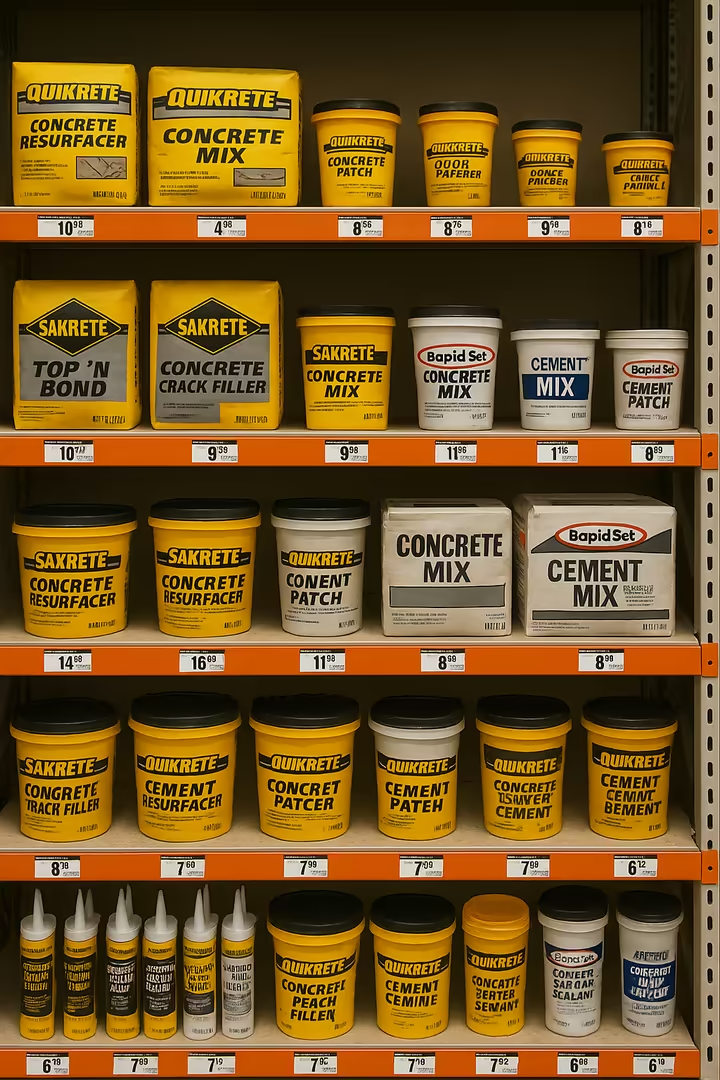
Quikrete®
Quikrete® offers a comprehensive portfolio of repair products for most common concrete issues. Their line includes Vinyl Concrete Patcher for thin repairs, high-strength Polymer Modified Structural Repair for load-bearing uses, flexible Concrete Repair caulk for small cracks, and Hydraulic Water-Stop Cement for active leaks. 11, 8, 23, 35
Sakrete®
Sakrete® provides a parallel catalog of products for concrete repair and maintenance. Key offerings include the Fast-Setting Cement Patcher for rapid repairs, the versatile Top 'N Bond Concrete Patcher , and Self-Leveling Underlayment for interior floors. 28, 36, 38
Rapid Set®
Rapid Set® and its associated brands focus on extremely fast-setting products that enable a quick return to service. These materials use calcium sulfoaluminate (CSA) cement chemistry, which gains strength faster than traditional Portland cement. Products like Rapid Patch® Concrete Repair Mortar are engineered for projects where minimizing downtime is a priority. 32, 38
Ardex®
Ardex® is a professional-grade brand known for high-performance formulations in the flooring and substrate preparation industries. The ARDEX CP™ Concrete Patch is a versatile, trowel-grade topping used to repair and re-slope a wide variety of interior and exterior concrete surfaces. 42, 43
Bondo®
Bondo®, a 3M brand, markets its All-Purpose Putty for household repairs on masonry and concrete. This is a two-part polyester resin filler, not a cementitious patch. Its advantages include a fast cure time, a non-shrinking nature, and a strong chemical bond, making it best suited for cosmetic fixes rather than structural repairs. 45, 46
The Patching Process
How to Select a Product
First, consider the repair's size and depth . Use flexible acrylic or polyurethane caulks for hairline cracks (less than 1/8 inch wide). For shallow spalls up to 1/4 inch deep, vinyl-reinforced patchers are suitable, while damage deeper than 1/4 inch requires robust polymer-modified mortars. 9, 27
The repair's location matters. Vertical or overhead repairs require a non-sag mix that resists slumping and stays in place against gravity. Also consider the expected load and traffic . Surfaces with vehicle traffic need high-strength, load-bearing materials like polymer-modified structural repair compounds. 14, 51, 52
Finally, consider environmental factors and desired cure time . Outdoor repairs in freezing climates require products resistant to freeze-thaw cycles. If a surface must be returned to service quickly, a fast-setting product is the only option. 2, 6
Surface Preparation
Proper surface preparation is the most important factor for a durable patch. Start with thorough cleaning to remove bond-breakers like dirt, grease, oil, or paint. A pressure washer and a concrete degreaser are effective for this step. 57, 60
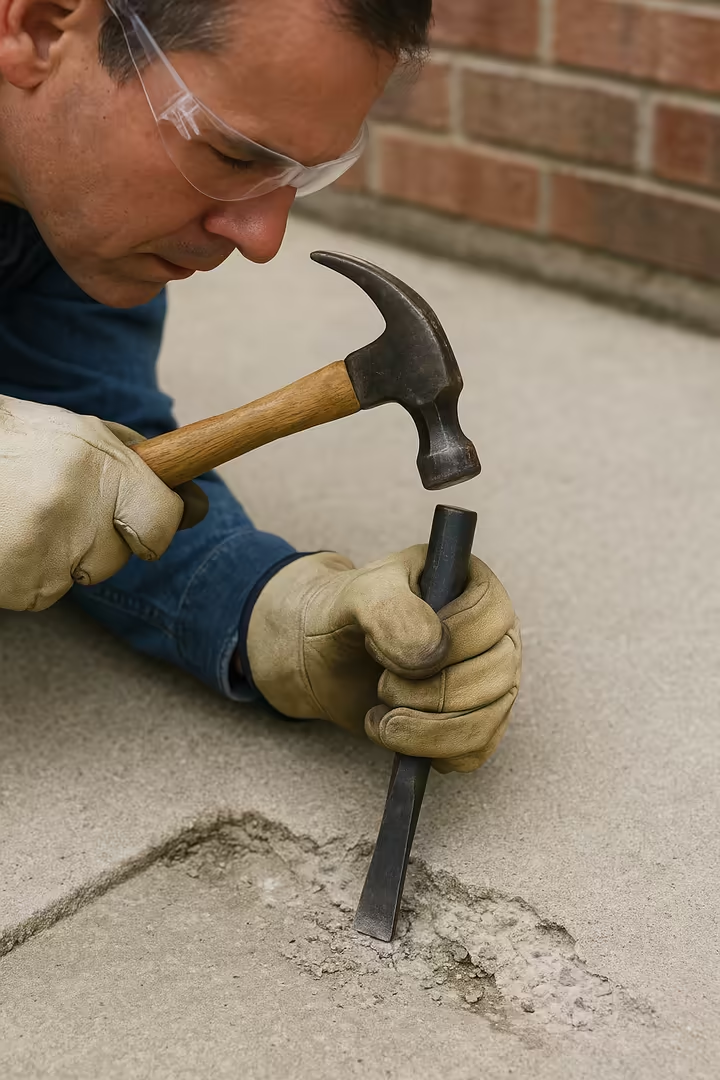
Next, remove all loose and unsound concrete using a hammer and chisel or a grinder until a solid substrate is exposed. For deeper repairs, undercutting the edges of the patch area provides a mechanical lock. This involves chiseling the perimeter so it is vertical or angled slightly inward at the bottom. 50, 58, 64
For most cementitious repairs, the surface must be in a Saturated Surface Dry (SSD) condition. Existing dry concrete will absorb water from the new patch, weakening the bond. To prevent this, dampen the substrate until it is saturated, then remove any standing water so the surface appears damp but is not wet to the touch. 65
A bonding agent or primer may be necessary if specified by the manufacturer or on very smooth surfaces. Many modern polymer-modified products are self-priming and do not require one. Work must be done within the manufacturer's specified temperature and moisture range, typically 40°F to 90°F (4°C to 32°C). 3, 9, 30
Mixing, Application, and Finishing
For mixing , strictly follow the manufacturer's instructions for the water-to-mix ratio. Adding too much water weakens the patch. Mix thoroughly for the specified time until the consistency is uniform and lump-free. 12, 62
For application , begin with a thin "scratch coat" of the material, using heavy trowel pressure to work it into the pores of the existing concrete. Immediately apply the rest of the material, pressing it firmly into the void to eliminate air pockets. If a repair is deeper than the product's maximum thickness for a single lift, apply it in layers, allowing each to set before adding the next. 3, 9, 73
For finishing , slightly overfill the repair and use a straight-edged tool to strike off the excess, making it level with the surrounding surface. To match the existing texture, use a steel trowel for a smooth finish or a stiff broom for a slip-resistant "broom finish." A new patch will almost always have a different color and texture than the surrounding aged concrete. 74, 77
Curing the Patch
Curing is a chemical process, not simple drying. The patch needs to stay moist so the cement can react with water to form the strong crystalline bonds that give it strength. If it dries out too quickly from exposure to sun or wind, it will be weak, porous, and prone to cracking. 65, 71
To ensure a proper cure, keep the patch continuously moist for the time recommended by the manufacturer, typically three to five days for traditional products. Common methods include covering the area with plastic sheeting or periodically misting the surface with water. Always follow the product-specific data sheet for curing instructions, as modern compounds may have different requirements. 12, 74, 80
Advanced Repair Techniques
Repairing Specific Defect Types
For hairline cracks (less than 1/8 inch wide), clean the crack and seal it with a flexible acrylic or polyurethane sealant to prevent water ingress. For spalls , chip away all unsound concrete, undercut the edges, prepare the area to an SSD state, and fill it with a polymer-modified mortar. 27, 81
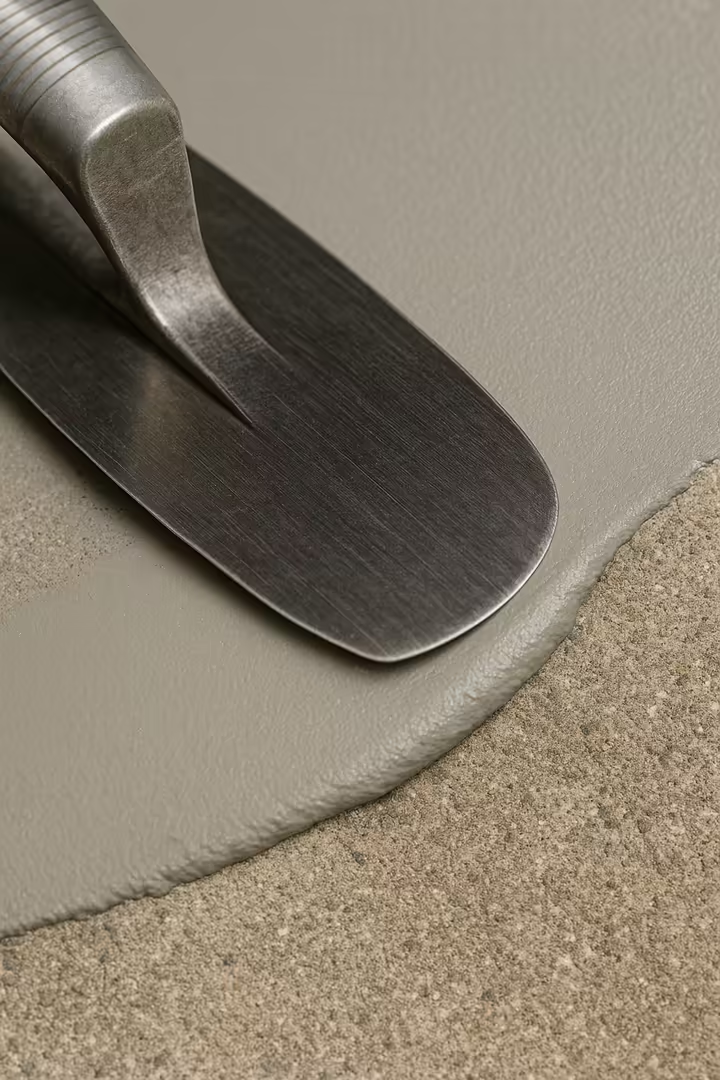
For scaling (flaking of the top surface), grind down the damaged layer and apply a concrete resurfacer. For pop-outs , chip out the reactive aggregate and surrounding fractured concrete, then fill the small void with patching mortar. For widespread pitting , grind the entire surface, fill the pits, and grind again for a smooth finish before applying a protective sealer. 83, 85, 87
Never fill control and expansion joints with rigid patching material. Repair damaged joint edges with a suitable mortar. Once cured, fill the joint with a flexible backer rod and a polyurethane or elastomeric sealant to allow for slab movement. 27, 88
Ensuring Patch Longevity
To create a seamless edge, a technique called feathering is used with specially formulated vinyl-reinforced or feather-edge compounds. These products maintain a strong bond even when troweled to a near-zero edge. Standard mixes will chip and fail if feathered. 9, 34
For reinforcing deep patches , drill horizontally into the existing slab and epoxy steel rebar dowels to tie the new patch to the old concrete. This ensures they move as a single unit. For deep voids, extend the repair mortar with pea gravel as directed by the manufacturer. 12, 91
For color and aggregate matching , add integral color pigments to the mix, or apply a color-matched concrete stain over the cured patch and surrounding area. For the most consistent finish, apply a complete concrete overlay to the entire surface. 78, 79
Finally, thermal expansion compatibility is key for exterior patches. Cementitious repair materials have a similar thermal expansion rate to base concrete. Epoxy compounds expand and contract at a much higher rate, which can be mitigated by using epoxy mortars heavily filled with aggregate. 7, 15, 93
Patching Before Painting
When patching before painting, the two stages are part of a single system. Allow cementitious patches to cure fully before painting. Fresh patches have high moisture and alkalinity, which can cause paint to blister, peel, or be chemically attacked (saponification). 94
The standard cure time for new concrete before painting is a minimum of 28 days. Although some fast-setting products allow for shorter wait times, always follow the manufacturer's technical data sheet. A simple moisture test, like taping plastic to the surface for 24 hours to check for condensation, can verify dryness. 68, 94
A quality masonry primer is critical for a uniform finish. Primer seals the porous surfaces of both the patch and the old concrete, equalizes absorption for a uniform topcoat, blocks salts (efflorescence), and improves adhesion. This ensures the paint adheres well to all parts of the surface. 31, 97
Common Mistakes to Avoid
Most patch failures are due to procedural errors. Inadequate surface preparation , such as applying a patch to a dirty or weak surface, is the most common cause of failure. 58
Using the wrong product for the job, like an interior filler for an exterior repair, can also lead to failure. Improper mixing , especially adding too much water, dramatically reduces the patch's strength. 59
Skipping the curing process allows a patch to dry too quickly, resulting in a weak, crack-prone repair. Lastly, failing to honor existing joints by patching over them will cause the patch to crack when the slab moves. 58, 59
Safety and Environmental Considerations
Handling Materials and Waste Safely
Cutting or grinding concrete releases fine respirable crystalline silica dust, which can cause incurable lung disease. Use wet methods (water-fed tools) or tools with a vacuum dust collection system connected to a HEPA filter to control dust at the source. 100
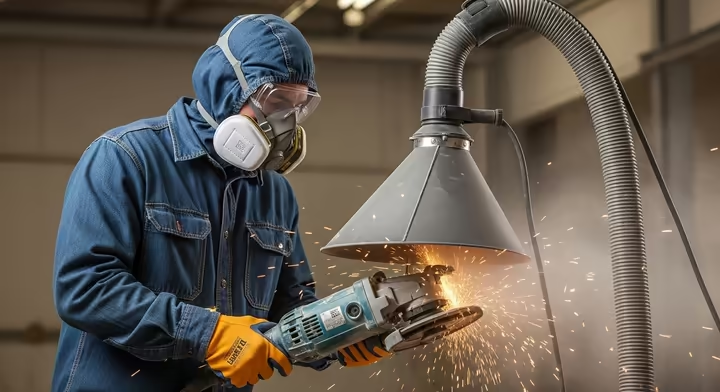
Wear proper Personal Protective Equipment (PPE) . This includes a fitted N95-rated respirator, ANSI-rated safety glasses, and waterproof, alkali-resistant gloves. Wet cement is highly alkaline and can cause severe chemical burns, so also wear long sleeves, pants, and waterproof boots. 100, 102, 103
Many coatings and sealers contain Volatile Organic Compounds (VOCs) , which are regulated by local air quality standards. Use products that are compliant in your area. 105
For material disposal , take leftover material and hardened waste to a designated construction and demolition (C&D) recycling facility. These facilities can crush old concrete for reuse as aggregate, reducing landfill waste. 107, 108
Works cited
- ri-repair.com, https://ri-repair.com/understanding-concrete-patching-repairing-small-areas-of-damage/#:~:text=Concrete%20patching%20is%20a%20vital,lifespan%20of%20the%20concrete%20structure.
- Understanding Concrete Patches: Types, Applications, and Benefits - TSS Supply, https://tsssupply.com/understanding-concrete-patches-types-applications-and-benefits/
- Concrete Patching: How to Bond to Existing Concrete for Best Results - Sakrete, https://www.sakrete.com/blog/post/concrete-patching/
- Why Does Concrete Crack and Spall: Prevention & Repair Insights, https://www.valcourt.net/blog/why-does-concrete-crack-and-spall-and-how-can-it-be-prevented/
- Patching Compounds for Concrete Repair and Surface Restoration - Hong Teck Hin, https://www.hongteckhin.com.sg/blogs/news/patching-compounds-for-concrete-repair-and-surface-restoration
- Choosing the Right Concrete Repair Material for Your Project - Grand Seal, https://grandseal.co/choosing-the-right-concrete-repair-material-for-your-project/
- The Selection of Concrete Repair Materials | Mapei, https://www.mapei.com/za/en/news-and-events/event-detail/2020/04/29/the-selection-of-concrete-repair-materials
- www.homedepot.com, https://www.homedepot.com/p/Quikrete-20-lb-Polymer-Modified-Structural-Concrete-Repair-124125/207102852#:~:text=Polymer%20Modified%20(PM)%20Structural%20Repair,a%20bonding%20and%20application%20agent.
- VINYL CONCRETE PATCHER - Quikrete, https://www.quikrete.com/pdfs/data_sheet-vinyl%20concrete%20patcher%201133.pdf
- Sika SikaLatex 1 Gal. Concrete Bonding Adhesive and Acrylic Fortifier 187782 - The Home Depot, https://www.homedepot.com/p/Sika-SikaLatex-1-Gal-Concrete-Bonding-Adhesive-and-Acrylic-Fortifier-187782/202521398
- Quikrete 10 lb. Vinyl Concrete Patch Repair 113311 - The Home Depot, https://www.homedepot.com/p/Quikrete-10-lb-Vinyl-Concrete-Patch-Repair-113311/100318504
- Polymer Modified Structural Repair, https://images.thdstatic.com/catalog/pdfImages/e8/e89877e1-7a56-4566-b387-3b79bb01a8c3.pdf
- POLYMER MODIFIED STRUCTURAL REPAIR - Unilog, https://assets.unilogcorp.com/187/ITEM/DOC/Quikrete_102543078_Specification_Sheet.pdf
- Quikrete 20 lb. Polymer Modified Structural Concrete Repair 124125 - The Home Depot, https://www.homedepot.com/p/Quikrete-20-lb-Polymer-Modified-Structural-Concrete-Repair-124125/207102852
- Epoxy-based Compounds used with Concrete | Holderchem, https://holderchem.net/en/articles/posts/batimix-epoxy-based-compounds-solution/
- Concrete Repair Patch Hi-Mod Structural Epoxy - Chemex Industries Inc, https://www.chemexindustries.com/concrete-repair-patch-hi-mod-structural-epoxy
- Performance of Epoxy Resin Polymer as Self-Healing Cementitious Materials Agent in Mortar - PMC, https://pmc.ncbi.nlm.nih.gov/articles/PMC7961462/
- CHAPTER 6 STRUCTURE CONCRETE REPAIR AND REHABILITATION - Caltrans, https://dot.ca.gov/-/media/dot-media/programs/engineering/documents/structureconstruction/ctm/sc-ctm-chpt6-a11y.pdf
- What is Hydraulic Cement? 9 Distinct Uses of This Material - Drylok, https://www.drylok.com/learn/blog/what-is-hydraulic-cement-9-distinct-uses-for-this-versatile-material
- What Is Hydraulic Cement and What Is It Used For? - The Spruce, https://www.thespruce.com/what-is-hydraulic-cement-uses-and-how-to-apply-845076
- Hydraulic Cement - US SPEC Grouts and Concrete Products, https://usspec.com/products/product/hydraulic-cement/
- Vinyl Concrete Patcher - Quikrete, https://www.quikrete.com/dealers/products/vinylconcretepatcher.asp
- QUIKRETE® - Concrete Repair, https://www.quikrete.com/dealers/products/concreterepair.asp
- CONCRETE REPAIR ACRYLIC LATEX 10OZ at Hamilton Building Supply | Masonry Products, https://store.hbsnj.com/p/concrete-repair-acrylic-latex-10oz/6912711
- Concrete Patching Compound | QUIKRETE: Cement and Concrete Products, https://www.quikrete.com/productlines/concretepatchingcompound.asp
- Concrete Repair | QUIKRETE: Cement and Concrete Products, https://www.quikrete.com/productlines/concreterepair.asp
- TRAINING MODULE: 7 Concrete Repair Products ... - Quikrete, https://www.quikrete.com/dealers/training/presentations/7-concrete-repair-techniques.pdf
- Self Leveling Underlayment | Sakrete, https://www.sakrete.com/product/self-leveling-underlayment/
- Self-Leveler Plus | Mapei, https://www.mapei.com/ca/en-ca/products-and-solutions/products/detail/self-leveler-plus
- SikaLevel Self-Leveling Underlayment - Sika USA Retail, https://retail.usa.sika.com/en/products/subfloor-covering/underlayments/sikalevel-self-leveling-underlayment
- Rapid Set 1 Gal. Concrete Leveler Primer 191040000 - The Home Depot, https://www.homedepot.com/p/Rapid-Set-1-Gal-Concrete-Leveler-Primer-191040000/204414405
- Patches - TCC Materials, https://www.tccmaterials.com/products/floor-preparation/patches/
- Fast Feather-Fast Setting Feather Edge Repair Mortar | Concrete-Texturing.com, https://www.concrete-texturing.com/product/fast-feather-fast-setting-feather-edge-repair-mortar/
- What is the Best Concrete Mix for a Feathered Edge? - YouTube, https://www.youtube.com/watch?v=2pVCUHa5Zdk
- QUIKRETE® Concrete Repair Product Sets, https://www.quikrete.com/concrete-repair-product-sets/
- Sakrete Concrete Repair - Walmart, https://www.walmart.com/c/kp/sakrete-concrete-repair
- Products We Offer | Sakrete, https://www.sakrete.com/products/
- Fast-Setting Cement Patcher - Sakrete, https://www.sakrete.com/product/fast-setting-cement-patcher/
- Sakrete Repair Fast Setting 10.1 -oz Stucco Concrete Crack repair - Lowe's, https://www.lowes.com/pd/Sakrete-10-3-oz-Concrete-Repair/1000235753
- Rapid Patch® Concrete Repair Mortar - TCC Materials, https://www.tccmaterials.com/product/rapid-patch-concrete-repair-mortar/
- Concrete Quick Patch - 2343 - QuestMark, https://www.questmarkflooring.com/concrete-quick-patch-2343.html
- ARDEX CP (CONCRETE PATCH), https://shop.bcdecorative.com/products/ardex-cp-concrete-patch
- ARDEX CP is a concrete patch for minor concrete repairs, https://www.ardexamericas.com/product/ardex-cp/
- Ardex CP Concrete Patch, 40lb Bag - Discount Contractor Supply, https://discountcontractorsupply.com/products/ardex-cp-concrete-patch-40lb-bag
- Bondo® Filler & Resin - 3M, https://www.3m.com/3M/en_US/bondo-us/
- Bondo Home Solutions 1 qt. All-Purpose Putty 20052 - The Home ..., https://www.homedepot.com/p/Bondo-Home-Solutions-1-qt-All-Purpose-Putty-20052/202077805
- Bondo Concrete Repair - Large Repairs & Breakage - Fountainful, https://fountainful.com/products/bondo-concrete-repair-3m-corporation
- Concrete Repair Techniques | Association of State Dam Safety, https://damsafety.org/dam-owners/concrete-repair-techniques
- Understanding the Different Types of Concrete Repair Methods, https://proliftcrr.com/blogs/prolift-home-guide/understanding-the-different-types-of-concrete-repair-methods
- How to Do Concrete Repairs: Fixing Cracks, Holes, and Damage, https://swfunk.com/news/how-to-do-concrete-repairs/
- Vertical Repair Mortar Vertical Patch is also an Overhead Spall Repair - Nox-Crete, https://www.nox-crete.com/products/vertical-patch/
- Vertical Overhead Repair Mortars - Sika USA, https://usa.sika.com/en/construction/repair-protection/mortars/vertical-overhead.html
- Concrete Applications - Patching, Structural – Vertical & Overhead | Atlas Construction Supply, Inc., https://www.atlasform.com/pages/Atlas%20Applications/Patching,%20Structural%20-%20Vertical%20&%20Overhead.html
- Delpatch™ Elastomeric Concrete: A Go-To Repair Solution - D.S. Brown, https://dsbrown.com/delpatch-elastomeric-concrete-a-go-to-repair-solution/
- How to Protect Your Concrete from Freeze/Thaw Damage | UNIQUE Paving Materials, https://www.uniquepavingmaterials.com/protect-concrete-from-freeze-thaw-damage-with-unique-paving-materials/
- Seal the Deal : Concrete Freeze/Thaw Damage - ChemMasters, https://www.chemmasters.net/newsletters/2013-11/index.php
- Best Practices for Concrete Surface Preparation - ITW Performance Polymers, https://itwperformancepolymers.com/blog/best-practices-for-concrete-surface-preparation
- Concrete Tip of the Week: Partial-Depth Concrete Patch Failures - UNIQUE Paving Materials, https://www.uniquepavingmaterials.com/concrete-tip-week-partial-depth-concrete-patch-failures/
- Avoiding Common Concrete Repair Mistakes | Houston | American ..., https://www.americanpavingtx.com/avoiding-common-concrete-repair-mistakes/
- specchem.com, https://specchem.com/resources/concrete-surface-preparation-concrete-repairs/#:~:text=Dust%2C%20debris%2C%20oils%2C%20and,or%20pressure%20washing%20are%20recommended.
- Essential steps for concrete surface preparation | Thomas Industrial, https://www.thomasindcoatings.com/four-essential-steps-for-concrete-surface-preparation/
- Making Thin Repairs to Damaged Concrete - Quikrete, https://www.quikrete.com/athome/video-thin-repairs.asp
- www.quikrete.com, https://www.quikrete.com/athome/video-thin-repairs.asp#:~:text=Clean%20the%20surface%20of%20the,disk%20and%20a%20portable%20drill.
- swfunk.com, https://swfunk.com/news/how-to-do-concrete-repairs/#:~:text=Undercut%3A%20Using%20a%20chisel%20and,securely%20to%20the%20surrounding%20concrete.
- Untitled - BoulderScape, https://boulderscape.com/wp-content/uploads/2018/09/Shotcrete-SSD-Surface-Saturated-Dry-Article.pdf
- Saturated, Surface Dry Method (SSD) - Stucco Supply Co, https://www.stuccosupplyco.com/wp-content/uploads/2020/02/Saturated-Surface-Dry-Spec-Sheets-English.pdf
- When to Use A Concrete Bonding Adhesive Agent - E-Chem, https://e-chem.net/blog/when-to-use-concrete-bonding-adhesive/
- Concrete Patching Compound - Quikrete, https://www.quikrete.com/pdfs/data_sheet-concretepatchingcompound.pdf
- DAP® Ready Mixed Concrete Patch - BuildSite, https://www.buildsite.com/pdf/dap/DAP-Ready-Mixed-Concrete-Patch-Product-Data-2217166.pdf
- www.quikrete.com, https://www.quikrete.com/athome/video-thin-repairs.asp#:~:text=Mix%20Vinyl%20Concrete%20Patcher%20by,and%20compressive%20strength%20will%20be.
- Common Concrete Construction Mistakes and How to Fix Them - Pride Development, https://pridedevelopment.net/construction/common-phoenix-concrete-construction-mistakes-fix/
- www.sakrete.com, https://www.sakrete.com/blog/post/concrete-patching/#:~:text=The%20most%20effective%20way%20to,turn%20the%20stuff%20into%20slop.
- www.quikrete.com, https://www.quikrete.com/athome/video-thin-repairs.asp#:~:text=Stir%20Concrete%20Patching%20Compound%20using%20a%20margin%20trowel%20or%20putty%20knife.&text=Spread%20and%20texture%20the%20concrete,dry%20before%20applying%20the%20next.
- STEP 1 - REPAIRING HAIRLINE CRACKS STEP 2 REPAIRING ..., https://cdn.ymaws.com/www.rfmaonline.com/resource/resmgr/crfp/howtorepairconcrete.pdf
- Sikacryl Ready-Mix Concrete Patch - Sika USA Retail, https://retail.usa.sika.com/en/support/video/sikacryl-ready-mix-concrete-patch
- Pro Tips: How To Repair Broken Concrete Edges | DIY ... - Sakrete, https://www.sakrete.com/project-guide/repairing-broken-concrete-edges-and-deep-damage/
- Concrete patch - how to get it close in color and texture? : r/Concrete, https://www.reddit.com/r/Concrete/comments/16u6jyz/concrete_patch_how_to_get_it_close_in_color_and/
- Concrete repair looks awful, how can I make it match? I know it's still a little wet but I absolutely hate it. : r/Home - Reddit, https://www.reddit.com/r/Home/comments/108ng60/concrete_repair_looks_awful_how_can_i_make_it/
- How to Make New Concrete Look Old - Tips for a Seamless Match ..., https://www.concretenetwork.com/concrete-repair/how-to-make-new-concrete-match-old.html
- How Does Concrete Patch Dry? - Remote Estimation, https://remoteestimation.us/how-does-concrete-patch-dry/
- How to Fix Spalling Concrete | Kirchner Building Centers | Aviston ..., https://kirchnerbuildingcenters.com/blog/71558/how-to-fix-spalling-concrete#:~:text=Use%20the%20appropriate%20resurfacing%20mix,temperature%2C%20moisture%2C%20etc.)
- Concrete Surfaces Spalling - Sherwin-Williams - YouTube, https://www.youtube.com/watch?v=Uj_BTrVhoIU
- Concrete Scaling: Causes, Signs, Prevention & Repair Tips, https://ssconcretepolishing.com/concrete-scaling/
- Confix EC: How to Repair Concrete Scaling on High-Traffic Areas [8000psi at 3mm], https://www.youtube.com/watch?v=VqcgwB-S2OY
- POPOUTS - CONCRETE SASK, https://concretesask.org/images/Resources/ConcreteTechnicalTips/eNews_TECH_Tip_17_-_Popouts.pdf
- Aggregate Popouts - Concrete Answers, https://www.concreteanswers.org/CIPs/CIP40.htm
- How to Repair Pitted Concrete: A Step-by-Step Guide - Onfloor, https://blog.onfloor.com/how-to-repair-pitted-concrete
- Control Joint Repair : r/Concrete - Reddit, https://www.reddit.com/r/Concrete/comments/1bclshu/control_joint_repair/
- Concrete Expansion Joint Repair: Causes And Effects - Houck, https://www.houcks.com/blog/concrete-expansion-joint-repair-causes-effects/
- What Causes Concrete Delamination and How To Avoid It ..., https://www.concretenetwork.com/concrete-delamination.html
- How to re-pour concrete in saw-cut slab? - Fine Homebuilding, https://www.finehomebuilding.com/forum/how-to-re-pour-concrete-in-saw-cut-slab
- www.concretenetwork.com, https://www.concretenetwork.com/concrete-repair/how-to-make-new-concrete-match-old.html#:~:text=You%20can%20also%20work%20with,to%20achieve%20the%20desired%20shade.
- Thermal Behavior of Concrete: Understanding the Influence of Coefficient of Thermal Expansion of Concrete on Rigid Pavements - MDPI, https://www.mdpi.com/2076-3417/15/6/3213
- How Long Does Concrete Need To Cure Before Painting? - Civil Engineering Explained, https://www.youtube.com/watch?v=2LLh0ygRDZs
- New Concrete - Cure Time before Painting - Rust-Oleum, https://rustoleumsupport.zendesk.com/hc/en-us/articles/4404480878349-New-Concrete-Cure-Time-before-Painting
- Concrete Repair Surface Preparation - Primer - Conproco, https://conproco.com/product/primer/
- BEHR PREMIUM 1 Gal. Concrete and Masonry Bonding Primer 88001 - The Home Depot, https://www.homedepot.com/p/BEHR-PREMIUM-1-Gal-Concrete-and-Masonry-Bonding-Primer-88001/100129649
- How to Repair a Cold Joint in Concrete? (Effectively!) - Construction Front, https://constructionfront.com/concrete-cold-joint-repair/
- Cold Joints in Concrete: Causes, Risks, and Repair Solutions - The Mudjacking Contractor, https://mudjackingcontractor.com/blog/cold-joints-in-concrete-causes-risks-and-repair-solutions/
- How Do You Control Hazards of Silica in Construction? - California Department of Industrial Relations, https://www.dir.ca.gov/dosh/etools/08-019/control.htm
- Protecting workers from crystalline silica hazards in the workplace, https://www.tdi.texas.gov/tips/safety/silica.html
- Concrete Safety Gear Checklist - MCR Safety - B2B, https://www.mcrsafety.com/blog/concrete-safety-gear-checklist
- Concrete Safety Gear Checklist, https://www.mcrsafety.com/blog/concrete-safety-gear-checklist/
- Understanding Concrete Patching: Repairing Small Areas of Damage - RI Repair, https://ri-repair.com/understanding-concrete-patching-repairing-small-areas-of-damage/
- Seal the Deal : What Are VOCs - ChemMasters, https://www.chemmasters.net/newsletters/2013-05/article2.php
- Adhesives and Sealants - TBF Environmental, https://tbfenvironmental.com/vocmir-regulations/voc-and-mir-regulations-by-industrial-solvent-application/adhesives-and-sealants/
- How To Dispose of Concrete - The Home Depot, https://www.homedepot.com/c/ah/how-to-dispose-of-concrete/9ba683603be9fa5395fab90139b31d64
- How to Dispose of Leftover Concrete, https://arcosacrushedconcrete.com/blog/how-to-dispose-of-leftover-concrete/